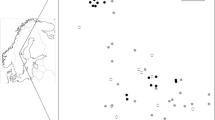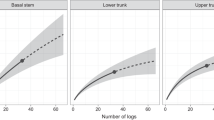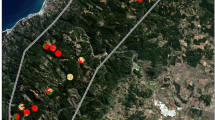Abstract
Logging significantly reduces the proportion of late-seral stands in managed boreal landscapes. Availability of habitat elements typical of these stand types, such as standing dead wood, decreases, and dependant species may have their abundance reduced or become locally extirpated, potentially affecting the ecosystem processes/services in which they take part. We evaluated the impact of habitat loss on saprophagous wood-boring beetles (Coleoptera: Cerambycidae) in an aspen-dominated landscape intensively logged for the past 30 years. Sixty natural snags of middle decay class were chosen along a gradient of habitat loss and disturbance age, cut down and dissected for beetle larvae. We then assessed relationships between species occurrence and percentage of residual cover and age of disturbance at spatial scales ranging from 40 to 2000 m radii. The most common species, Anthophylax attenuatus, showed no response, being abundant regardless of the intensity of habitat loss. The second most common species, Bellamira scalaris, showed a negative response, especially in sites which had been fragmented for a longer time. A third species, Trachysida mutabilis, showed an inverse trend, having a higher probability of presence where habitat loss was more severe. Our study shows that some saprophagous wood-borers do react negatively to habitat loss, but that within a relatively homogenous group the response can vary significantly between species. Saprophagous wood-borers should be considered potentially sensitive to habitat loss, and their response to fragmentation remains to be evaluated on a longer time frame.





Similar content being viewed by others
References
Angelstam PK (1998) Maintaining and restoring biodiversity in European boreal forests by developing natural disturbance regimes. J Veg Sci 9:593–602
Angers VA, Drapeau P, Bergeron Y (2010) Snag degradation pathways of four North American boreal tree species. For Ecol Manag 259:246–256
Bélisle M, Desrochers A, Fortin MJ (2001) Influence of forest cover on the movements of forest birds: a homing experiment. Ecology 82:1893–1904
Belleau A, Bergeron Y, Leduc A, Gauthier S, Fall A (2007) Using spatially explicit simulations to explore size distribution and spacing of regenerating areas produced by wildfires: recommendations for designing harvest agglomerations for the Canadian boreal forest. For Chron 83:72–83
Berg A, Ehnstrom B, Gustafsson L, Hallingback T, Jonsell M, Weslien J (1994) Threatened plant, animal, and fungus species in Swedish forests: distribution and habitat associations. Conserv Biol 8:718–731
Berg A, Ehnstrom B, Gustafsson L, Hallingback T, Jonsell M, Weslien H (1995) Threat levels and threats to red-listed species in Swedish forests. Conserv Biol 9:1629–1633
Bergeron Y, Flannigan M, Gauthier S, Leduc A, Lefort P (2004) Past, current and future fire frequency in the Canadian boreal forest: implications for sustainable forest management. Ambio 33:356–360
Boucher Y, Arseneault D, Sirois L (2009) Logging history (1820–2000) of a heavily exploited southern boreal forest landscape: insights from sunken logs and forestry maps. For Ecol Manag 258:1359–1368
Brook BW, Sodhl NS, Ng PKL (2003) Catastrophic extinctions follow deforestation in Singapore. Nature 424:420–423
Brooks TM, Mittermeier RA, Mittermeier CG, Da Fonseca GAB, Rylands AB, Konstant WR, Flick P, Pilgrim J, Oldfield S, Magin G, Hilton-Taylor C (2002) Habitat loss and extinction in the hotspots of biodiversity. Conserv Biol 16:909–923
Brunet J, Isacsson G (2009) Restoration of beech forest for saproxylic beetles—effects of habitat fragmentation and substrate density on species diversity and distribution. Biodivers Conserv 18:2387–2404
Craighead FC (1923) A classification and the biology of North American cerambycid larvae. Technical Bulletin no. 27, Canadian Department of Agriculture
Davies KF, Margules CR, Lawrence JF (2000) Which traits of species predict population declines in experimental forest fragments? Ecology 81:1450–1461
Desrochers A, Hannon SJ (1997) Gap crossing decisions by dispersing forest songbirds. Conserv Biol 11:1204–1210
Didham RK, Ghazoul J, Stork NE, Davis AJ (1996) Insects in fragmented forests: a functional approach. Trends Ecol Evol 11:255–260
Donovan TM, Jones PW, Annand EM, Thompson FR III (1997) Variation in local-scale edge effects: mechanisms and landscape context. Ecology 78:2064–2075
Drapeau P, Leduc A, Bergeron Y (2009a) Bridging ecosystem and multiple species approaches for setting conservation targets in managed boreal landscapes. Chapter 7. In: Villard M-A, Jonsson B-G (eds) Setting conservation targets in managed forest landscapes. Cambridge University Press, Cambridge, pp 129–160
Drapeau P, Nappi A, Imbeau L, Saint-Germain M (2009b) Standing deadwood for keystone bird species in the eastern boreal forest: managing for snag dynamics. For Chron 85:227–234
Edmonds RL, Eglitis A (1989) The role of the Douglas-fir beetle and wood borers in the decomposition of and nutrient release from Douglas-fir logs. Can J For Res 19:853–859
Environment Canada (2009) Canadian climate normals 1971–2000 [online]. Available from www.climate.weatheroffice.ec.gc.ca/climate_normals/index_e.html. Accessed 16 Sept 2009
Ewers RM, Didham RK (2006) Confounding factors in the detection of species responses to habitat fragmentation. Biol Rev Camb Philos Soc 81:117–142
Fahrig L (2003) Effects of habitat fragmentation on biodiversity. Annu Rev Ecol Evol Syst 34:487–515
Frazer GW, Canham CD, Lertzman KP (1999) Gap Light Analyzer (GLA), Version 2.0: imaging software to extract canopy structure and gap light transmission indices from true-colour fisheye photographs, users manual and program documentation. Simon Fraser University; The Institute of Ecosystem Studies, Burnaby, British Columbia; Millbrook, New York
Gauthier S, Vaillancourt MA, Morin H, Kneeshaw D, Leduc A, Drapeau P, Bergeron Y (2009) Ecosystem management in the boreal forest. Presses de l’Université du Québec, Québec, Canada, 539 pp
Gibb H, Hjaltén J, Ball J, Atlegrim O, Pettersson RB, Hilszczanski J, Johansson T, Danell K (2006) Effects of landscape composition and substrate availability on saproxylic beetles in boreal forests: a study using experimental logs for monitoring assemblages. Ecography 29:191–204
Gobeil JF, Villard MA (2002) Permeability of three boreal forest landscape types to bird movements as determined from experimental translocations. Oikos 98:447–458
Grove SJ (2002) Saproxylic insect ecology and the sustainable management of forests. Annu Rev Ecol Syst 33:1–23
Harper KA, Lesieur D, Drapeau P, Bergeron Y (2004) Forest structure and composition at young fire and cut edges in black spruce boreal forest. Can J For Res 34:289–302
Harper KA, Bergeron Y, Drapeau P, Gauthier S, De Grandpré L (2006) Changes in spatial pattern of trees and snags during structural development in Picea mariana boreal forests. J Veg Sci 17:625–636
Hély C, Bergeron Y, Flannigan MD (2000) Coarse woody debris in the southeastern Canadian boreal forest: composition and load variations in relation to stand replacement. Can J For Res 30:674–687
Henle K, Davies KF, Kleyer M, Margules C, Settele J (2004) Predictors of species sensitivity to fragmentation. Biodivers Conserv 13:207–251
Holland JD, Bert DG, Fahrig L (2004) Determining the spatial scale of species’ response to habitat. Bioscience 54:227–233
Holland JD, Fahrig L, Cappucino N (2005) Body size affects the spatial scale of habitat–beetle interactions. Oikos 110:101–108
Hooper DU, Chapin FS III, Ewel JJ, Hector A, Inchausti P, Lavorel S, Lawton JH, Lodge DM, Loreau M, Naeem S, Schmid B, Setälä H, Symstad AJ, Vandermeer J, Wardle DA (2005) Effects of biodiversity on ecosystem functioning: a consensus of current knowledge. Ecol Monogr 75:3–35
Lindhe A, Lindelow A, Asenblad N (2005) Saproxylic beetles in standing dead wood density in relation to substrate sun-exposure and diameter. Biodivers Conserv 14:3033–3053
Linsley EG, Chemsak JA (1976) The Cerambycidae of North America. Part VI. No. 2: Taxonomy and classification of the subfamily Lepturinae. Univ Calif Publ Entomol 80:1–186
Mascarúa-López LE, Harper KA, Drapeau P (2006) Edge influence on forest structure in large forest remnants, cutblock separators, and riparian buffers in managed black spruce forests. Ecoscience 13:226–233
Maser C, Anderson RG, Cromack Jr K, Williams JT, Martin RE (1979) Dead and down woody material. In Thomas UV (ed). Wildlife habitats in managed forests: the Blue Mountains of Oregon and Washington. USDA Forest Service Agriculture Handbook no. 553
Millennium Ecosystem Assessment (2005) Ecosystems and human well-being: synthesis. Island Press, Washington
Murphy EC, Lehnhausen WA (1998) Density and foraging ecology of woodpeckers following a stand-replacement fire. J Wildl Manag 62:1359–1372
Nappi A, Drapeau P, Giroux JF, Savard JP (2003) Snag use by foraging Black-backed Woodpeckers in a recently burned eastern boreal forest. Auk 120:505–511
Nappi A, Drapeau P, Saint-Germain M, Angers V-A (2010) Effect of fire severity on long-term occupancy of saproxylic beetles and bark-foraging birds in burned boreal conifer forests. Int J Wildland Fire 19:500–511
Östlund L, Zackrisson O, Axelsson AL (1997) The history and transformation of a Scandinavian boreal forest landscape since the 19th century. Can J For Res 27:1198–1206
Perera AH, Baldwin DJB (2000) Spatial patterns in the managed forest landscape of Ontario. In: Perera AH, Euler DL, Thompson ID (eds) Ecology of a managed terrestrial landscape: patterns and processes of forest landscapes in Ontario. UBC Press, University of British Columbia, Vancouver, BC, pp 74–99
Pimm SL, Raven P (2000) Biodiversity: extinction by numbers. Nature 403:843–845
Robinson SK, Thompson FR, Donovan TM, Whitehead DR, Faaborg J (1995) Regional forest fragmentation and the nesting success of Migratory birds. Science 267:1987–1990
Sahlin E, Ranius T (2009) Habitat availability in forests and clearcuts for saproxylic beetles associated with aspen. Biodivers Conserv 18:621–638
Saint-Germain M, Drapeau P, Buddle CM (2007a) Host-use patterns of saproxylic phloeophagous and xylophagous Coleoptera adults and larvae along the decay gradient in standing black spruce and aspen. Ecography 30:737–748
Saint-Germain M, Drapeau P, Buddle CM (2007b) Occurrence patterns of aspen-feeding wood-borers (Coleoptera: Cerambycidae) along the wood decay gradient: active selection for specific host types or neutral mechanisms? Ecol Entomol 32:712–721
Saunders DA, Hobbs RJ, Margules CR (1991) Biological consequences of ecosystem fragmentation: a review. Conserv Biol 5:18–32
Schiegg K (2000) Effects of dead wood volume and connectivity on saproxylic insect species diversity. Ecoscience 7:290–298
Schroeder D, Perera AH (2002) A comparison of large-scale spatial vegetation patterns following clearcuts and fires in Ontario’s boreal forests. For Ecol Manag 159:217–230
Sénécal D, Kneeshaw D, Messier C (2004) Temporal, spatial, and structural patterns of adult trembling aspen and white spruce mortality in Quebec’s boreal forest. Can J For Res 34:396–404
Švácha P, Danilevsky ML (1986) Cerambycoid larvae of Europe and Soviet Union (Coleoptera, Cerambycoidea) Part I. Acta Universitatis Carolinae – Biológica 30:1–176
Švácha P, Danilevsky ML (1987) Cerambycoid larvae of Europe and Soviet Union (Coleoptera, Cerambycoidea) Part II. Acta Universitatis Carolinae – Biológica 31:121–284
Švácha P, Danilevsky ML (1988) Cerambycoid larvae of Europe and Soviet Union (Coleoptera, Cerambycoidea) Part III. Acta Universitatis Carolinae – Biológica 32:1–205
Sverdrup-Thygeson A, Ims RA (2002) The effect of forest clearcutting in Norway on community of saproxylic beetles on aspen. Biol Conserv 106:347–357
Tilman D, May RM, Lehman C, Nowak M (1994) Habitat destruction and the extinction debt. Nature 371:65–66
Tscharntke T, Steffan-Dewenter I, Kruess A, Thies C (2002) Characteristics of insect populations on habitat fragments: a mini review. Ecol Res 17:229–239
Turner IM (1996) Species loss in fragments of tropical rain forests: a review of the evidence. J Appl Ecol 33:200–209
Vanderwel MC, Caspersen JP, Woods ME (2006) Snag dynamics in partially harvested and unmanaged northern hardwood forests. Can J For Res 36:2769–2779
Warner RR, Chesson PL (1985) Coexistence mediated by recruitment fluctuations: a field guide to the storage effect. Am Nat 125:344–366
Webb A, Buddle CM, Drapeau P, Saint-Germain M (2008) Use of remnant boreal forest habitats by saproxylic beetle assemblages in even-aged managed landscapes. Biol Conserv 141:815–826
Wikars LO (1994) Effects of fire and ecology of fire-adapted insects. Introductory research essay no. 12. Department of Zoology, Uppsala University, Sweden
Yaroshenko AY, Potapov PV, Turubanova SA (2001) The last intact forest landscapes of Northern European Russia. Greenpeace Russia, Moscow, 77 pp
Acknowledgments
Dave Gervais and Maryse Marchand provided help with fieldwork and wood dissection. Laboratories of the Lake Duparquet Research and Teaching Forest field station were used for dissection. TEMBEC Inc. gracefully provided logging history data for the study region. This project benefited from different funding sources including a Discovery grant to P. Drapeau from the Natural Science and Engineering Research Council of Canada (NSERC), a Fonds Québécois de la Recherche sur la Nature et les Technologies (FQRNT)—Équipe grant (Drapeau and collaborators) and additional funding by the partners of the NSERC industrial chair in sustainable forest management of Univ. du Québec en Abitibi-Témiscamingue (UQAT) and Univ. du Québec à Montréal (UQAM).
Author information
Authors and Affiliations
Corresponding author
Rights and permissions
About this article
Cite this article
Saint-Germain, M., Drapeau, P. Response of saprophagous wood-boring beetles (Coleoptera: Cerambycidae) to severe habitat loss due to logging in an aspen-dominated boreal landscape. Landscape Ecol 26, 573–586 (2011). https://doi.org/10.1007/s10980-011-9587-1
Received:
Accepted:
Published:
Issue Date:
DOI: https://doi.org/10.1007/s10980-011-9587-1




